In the region SE of Cambridge City, England, is the country town of Sawston, and immediately South is the village of Pampisford. It is here that we commence our Parsons story. The name Parsons is probably the least interesting of the family names in that its derivation is considered to simply refer to people or servants, who worked for the local Parson or Church Minister. For this very reason Parsons is a common name and widespread, although interestingly only 1% of ‘Parsons’ are considered to live in Cambridgeshire.
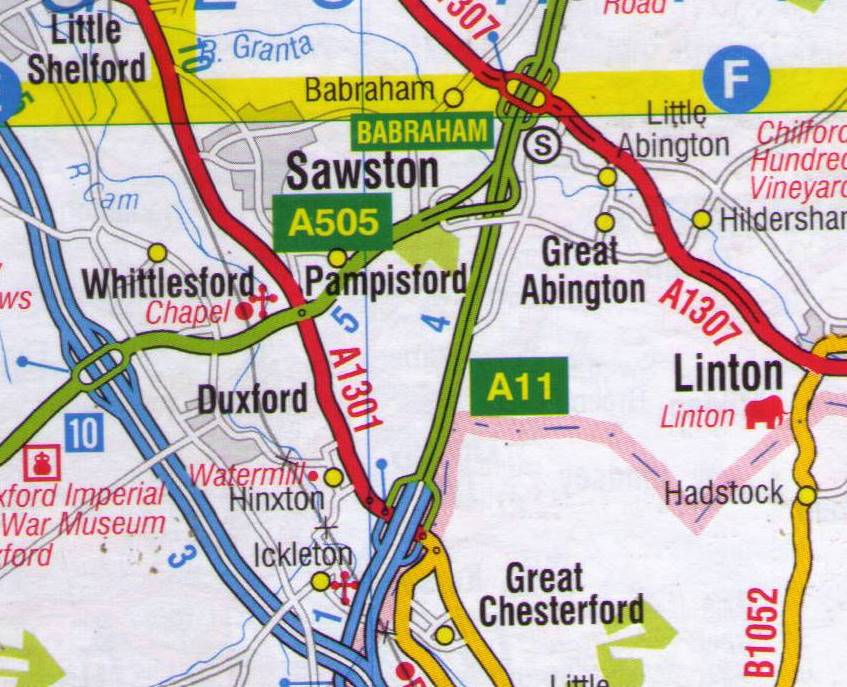
THE ARRIVAL OF AGRICULTURAL AND FORESTRY BASED INDUSTRIES
The location of Pampisford, immediately adjacent to country town Sawston, is crucial to the Parsons family story. Sawston at the turn of the 19th Century was rapidly becoming an industrial country town with the establishment of agricultural and forestry industries producing leather, paper, adhesives and fertilisers. As we will see these industries employed large numbers of people with factory labouring replacing agricultural labouring in the Parsons narrative. It seems quite likely that this industrial employment replaced the agricultural work, because it was not seasonal, wages were consistent and higher and all of the family could work in the one location, male and female.
In the mid 1700’s our Parsons family had been residing in Pampisford. All we know is that Mariah Parsons b1771 was the surviving elder in the community and was the mother of at least three sons and they were: Thomas b1793, John b1801 and Joseph b1806. We suspect that there were other siblings but they have not been identified in the records. So what do we know about these three Parsons sons? Well, we have traced our family ancestor line back to eldest son Thomas.
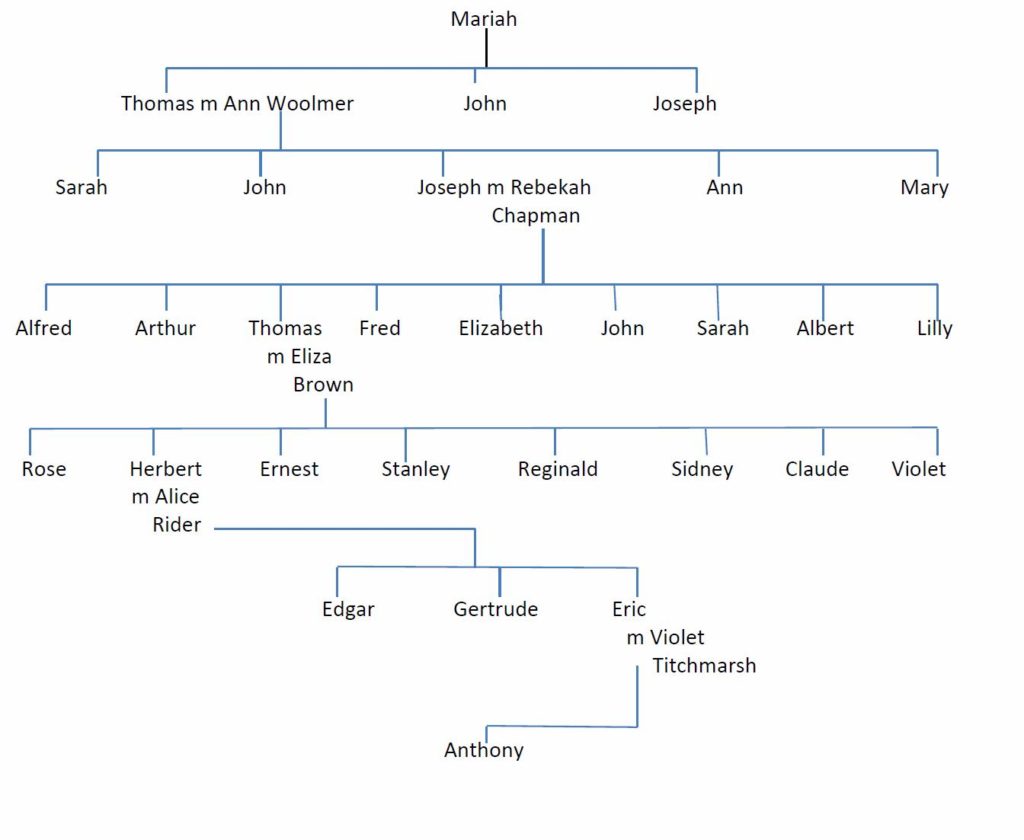
THOMAS SETS THE EXAMPLE FOR A FAMILY OF SHOP-KEEPERS AND TRADIES
Thomas was born in 1793 in Pampisford and most probably started work on the land when he was a teenager. In 1821 Thomas married Ann Woolmer b1798 from Litlington, Cambridgeshire. Litlington is about 20km from Pampisford. The couple married at Hinxton, another village, just South of Pampisford. A distance of 20kms in 1821 was not something you undertook easily. It is, therefore, more likely that Ann Woolmer was working in service or at least working and living in Sawston at this time.
Anne Woolmer was the daughter of another agricultural worker, Thomas Woolmer. Thomas b1862 was married to Susan Morris b 1867 of Litlington and her family had lived in this village for several generations.
Thomas Parsons and Ann had five children, that we are aware of, and they were Sarah b1825, John b1826, Joseph b1828, Ann b1830, and Mary b1835 and who died in that year. Thomas and Ann continued to live and work on the land around the Sawston region, spending some time living at the village of Duxford. On reaching their sixties they decided to retire from farm labouring and commenced the running of a General Dealership in Sawston High St. Thomas and Ann ran this shop until he died in 1876 and Ann in 1887. Stories from some of their children and grandchildren, show the impact of this industrializing period, including a parson in name and practice and a general move by several into small business enterprises.
SON JOHN AND FAMILY FIRST TRY INDUSTRIAL LABOURING
Thomas and Anne’s eldest son John, b1826, married Lucy Shefford b1829, from Great Chesterford in 1850. They had eight children and they continued to live in Sawston with John working as a labourer at the leather factory from his early years. In fact from the mid 1850’s to the mid 1880’s John and family lived in a rental cottage in Common Lane. John worked as a labourer in the skinning and parchment preparation sections of this factory for over 45 years, with all of his boys following suit. The girls, on the other hand, all worked at the Towgood paper factory in Sawston. The children of John and Lucy were John William b 1850, Elizabeth b1852, Jane b1856, Sarah b1861, Owen b1864, Ann Lucy b 1866, Albert b1868 and Alfred b 1869. John senior died in 1881 but Lucy was still working as a charwoman when she was 73 years of age and she lived to 95 years.
We have some further interesting history for John and Lucy’s children that also demonstrates the impact the local industry was having on families by the mid to late 1800’s. In the early years John William followed his father into employment at the leather factory, but eventually became a Congregational Minister. After a short term in Sawston he moved to Northallerton, Yorkshire and was Minister at the Zion Chapel, and by this time had married, in 1877, Ellen Button Broome b1850 from Cookham, Berkshire; who he met when she was a school mistress working with her brother, a school principal, in Helpringham, Lincolnshire. They had one child Hubert b 1880. John William died in 1904.
OTHERS TRY SHOP-KEEPING
Son Owen b1864 also started work at the leatherworks in Sawston but like his brother started to travel and by 1889 had met and married Edith from Holt, Wiltshire. In 1901 Owen is a widower but is running his own business as a Fruiterer and Greengrocer in Lambeth, London. Owen remarries Alice Winslow from Lambeth in 1903 and they move to Hackbridge, Surrey. By this time his business appears to have folded because he is now working at the local meatworks as a splitter and flesher. In 1911 Owen and Alice have one child living with them, Reginald John b 1904. Alice died in 1928 and Owen died in 1942.
Son Albert , after starting work as a labourer at the leather factory, followed his brother Owen to Lambeth, London, and assisted him in the fruit and grocery business. By 1911 Albert had moved out on his own and had established a Newsagent and Confectioners business in Balham Hill, Wandsworth, London. Albert married a dressmaker Louisa Packham in 1898; she was born in Yorkshire in 1877, but then living in Kent with her parents. Albert and Louisa had three children; Muriel Olive b1900, Thirza Amy b 1903 and Violet Ivy b 1910.
DOMESTIC SERVICE FOR THOMAS’ DAUGHTERS
So, returning to Thomas and Ann’s children. Their daughter Ann remained single all her life. She moved in the early years from Sawston to Cambridge and worked in domestic service for several families, including that of Charles Wooton a solicitor living at Emmanuel House, Emmanuel Road, Cambridge. By 1901 Ann had returned to her roots and owned her own lodging house at 10 City Road, Sawston, she was aged 64 years. Sister Sarah also entered domestic service from an early age and then married Stephen Morley b 1833, from Little Abington, Cambridgeshire in 1853.
Thomas and Ann’s youngest son Joseph continues our Parsons family line and we will have more to say about his family shortly, after we look at a short story for Thomas’s brothers, John and Joseph.
JOHN STAYS WITH AGRICULTURE
Thomas’s brother John married Susannah b1801, we think from Great Chesterford, and they had six children, Thomas b 1827, Sarah b1830, John b1833, Rebekah b1836, Joseph b1839 and Ann b1842. John senior worked as an agricultural labourer all of his life and they continued to live in Pampisford until he died early in the late 1830’s. Susannah is head of the Pampisford household in 1841 and 1851 and has sons John, Joseph and their sister Ann living with her. Susannah does not marry again and dies before 1871. What do we know about the children of John and Susannah?
Their eldest son Thomas marries Esther Barton b 1825 from Hinxton, Cambridgeshire and they have three children, Sarah b1855, John b1857 and Mary Ann b1859. Thomas lived in Pampisford and worked as an agricultural labourer for most of his life. He died in 1881.
John junior marries Emma Edwards from Babraham and they have at least six children, Jane b 1856, Henry John b1865, Pheobe Uriah 1870, Laura 1872, Alfred b1874 and William b1876. John continues as an agricultural labourer. John died in 1913 aged 81years.
Daughter Jane was a dressmaker in 1881, still single, but more than that we do not know.
John senior’s son Joseph married (1876) Annie Rowlinson b1848 from Pampisford and they have one son George Joseph b 1878. Joseph continued as an agricultural labourer and he dies in 1896.
We do not have any information on the other daughters Sarah and Rebekah or any of their families in later life.
JOSEPH DIES IN HIS FORTIES, STILL ON THE LAND
Thomas’s younger brother Joseph married Frances b1803 from Babraham and they had six children, Maria b1831, Joseph b1833, Mary Ann b1836, Fanney b1838, Samuel b1840 and Martha b1843. We believe Joseph Snr., also and agricultural labourer, died in about the mid 1840’s as Frances was the head of the household from that time until her death in 1883 at 82years. In 1871 Frances was working as a laundress with her daughter Maria. Daughter Maria remained single throughout her life, living with her mother in and around Pampisford.
Son Joseph junior married Jane Ann Moore, daughter of George Moore, from Hinxton and they had two children William and George. We have no information on daughters Mary or Fanny. Joseph Jnr. worked on the land all of his life.
Son Samuel married Matilda Dover in 1870 from Moulton, Sussex. Samuel had started work as an agricultural labourer but by 1871 he and Matilda were Publicans of the “Lordship” in Pampisford. Sometime in the next decade the couple also opened a General Dealership shop in Pampisford. In 1901 they were still in Pampisford, but at Sawston Road and were growing and marketing pigs. They had no children.
Daughter Martha joined her mother and sister Maria in the laundry after leaving school and to her early 20’s. She then married Henry Sergent an agricultural labourer from Sawston and they had four children, Fanny Maria, Frank, Matilda and Walter. Henry and Martha lived in Babraham throughout their lives.
In summarizing our ancestors to this point, you would have to say they are still very tied to the land as farm labourers. None seem to own land; all seem to work for the land owning farmers. There are the first signs of breaking away from this many generational activity with the younger generations being drawn into factory work for the higher and more consistent wages. Some entering small business as retailers, publicans and specialist farmers and there is more of this to come in Thomas’s son Joseph’s story.
FACTORY LABOUR TO COAL MERCHANT
Thomas and Ann’s son Joseph was born in 1828 in Sawston. At twelve years of age he had already joined his father and brother John working as a farm labourer. In 1850 Joseph was still an agricultural labourer but now, at 22, married to Rebekah Chapman from Sawston b 1830. Rebekah was the daughter of Richard and Elizabeth Chapman. Joseph and Rebekah’s first son Alfred was born in 1851. The couple eventually had nine children Alfred b1851, Arthur b1853, Thomas b1856, Frederick b1858, Elizabeth b1862, John b1864, Sarah b1866, Albert b1868 and Lilly b1874. Following their marriage, Joseph and Rebekah, first rented a small cottage at Morley’s Yard in Sawston. This most likely meant that Joseph was now working at the leather factory that was associated with the yard. With the children arriving and needing more space the couple decided to move to a rented house in Common Lane, Sawston. This would have been late 1850’s and Joseph had now started work as a labourer at the paper factory.
This paper manufacture had commenced in Sawston in the late 1600’s mainly due to the ready availability of water and raw materials. In the mid 1800’s the demand for paper was rapidly increasing and the new owner, Edward Towgood, modernised the plant and purchased land and houses surrounding the factory. He rented these houses to workers at the factory. In 1878 Towgood built five rows of brick terraces in New Road, Sawston for his workers, which now numbered over 400 employees, Joseph and Rebekah were one of the first families to be housed. Joseph worked at the paper factory for over 40 years and his son John joined him in 1878.
All the children had left home by 1891 and Joseph had ceased working at the paper factory and taken up Coal Hawking and at the same time they had moved house to High St. Sawston. Joseph continued hawking and carting coal, as the local Coal Merchant, until after 1901, when he was over 70 years. By the 1911 census Joseph and Rebekah were ‘old age pensioners’, had been married for over 60 years and had nine children and were still living at High St. Rebekah died in 1911 and Joseph in 1920 at the age of 91. Carting coal obviously kept him fit. Some background on ‘coal carting’ is probably useful at this point.
COAL HAWKING
In the late 1800’s, with the spread of the rail network, coal was available for household burning to generate heat and for cooking. The coal was collected from the rail yard stores by carters and delivered to homes. It was sold competitively by these carters who became known as coal hawkers. Coal carters carried sacks of coal weighing over 50kgs on their shoulders to the house coal cellar or hob. Sawston was actually a difficult proposition as the railway by-passed the town, despite the industrial activity. The coal had to be collected by horse and cart from the rail junction and yards at near by Whittlesford.
So what do we know about the children of Joseph and Rebekah? Eldest son Alfred b 1851 married Janet Allen b1853 from Sawston in 1875 and they had two daughters, Grace b1876 and May b1878. Alfred also stayed in Sawston throughout his life and was a gas stoker at the local gas works. Alfred and Janet lived at ‘The Baulks’, Sawston. The daughters variously worked at the paper factory or as glove machinists at the leather factory. Daughter May did not marry until she was 55years old and then to Alfred Allen b1884 a widower and son of her mother Janet’s brother, Arthur. There were no children and May died in 1965 aged 87 years, living at Sawston. Alfred Allen was a clerk at the Sawston Paper factory, by then owned by Spicer’s. Daughter and sister Grace disappears from the record after 1901, when she was still living at home.
Tony recalls:
‘I can recall visiting ‘Cousin May’ and the very large house they lived in at Sawston on Pampisford Rd. It was the biggest house of anybody in our family and they had a huge walnut tree and I would always be given a sugar bag of walnuts. After Alfred died May built a bungalow in the front yard and sold the main house and land. There is probably a story here but will investigate later.’
Son Frederick b1858 married (1884) Mary Rowlinson b1858 and they had children Edgar b1886, Gertrude b1889, Maud Alice b1892, Stanley b1896, and Florence b1899. Frederick became a Railway Signalman before 1901 and was living at Chesterton Junction in Cambridge fulfilling this role in 1911. Of the children, Edgar was a clerk at the cement works and Maud a tailoress.
Joseph’s son Arthur married Elizabeth Ayers b1850 from Sawston in 1872. They had seven children, Lilly b1874, Ellen b1875, Annie b 1876, Horace b 1878, Frederick b1880, Florence b 1886 and Albert b1888. Elizabeth died between 1888 and 1900 because Arthur remarried in that year to Mary Ann from Pampisford. There are no further children. Arthur also worked in the paper factory until the late 1800’s, as did Mary Ann. After that Arthur worked at the leather factory as a labourer and skin flesher.
We have no information on the lives of the daughters, Elizabeth, Sarah and Lilly after they leave home. Nor are there any further records for son John after 1881, when he was 17 years and also working at the paper factory. Son Albert became a stable lad at Chesterfield House, Newmarket in 1891 but after that there is no record of him either.
HOUSE PAINTERS AND PLUMBERS
So back to our ancestor Thomas, son of Joseph and Rebekah and his family history. Thomas was b1856 in Sawston. He married in 1876 Emma Eliza Brown also b1856 in Sawston and they had eight children, these were Rose b1877, Herbert b1881, Ernest b1883, Stanley b1886, Reginald b1888, Sidney b1890, Claude Ewart b1897 and Violet b1900.
Emma Eliza was the daughter of Thomas Brown from Pampisford and Emily Cracknell from Linton, who married in 1850. Thomas Brown died in 1858 and widow Emily then married James Dockerill in 1858 as she had three daughters to support. We have no records for James or Emily after 1861. Emily’s children were Sarah, Alice, Emma, Robert and Fanny. The older three children were Brown’s, the younger two were Dockerill’s. Fanny actually lived with Thomas and Emma, when she was aged 17 and working as a hand at the paper factory in Sawston.
Shortly after marrying Thomas and Emma moved into a cottage at Howell’s Yard. In 1881 they have daughter Rose and son Herbert to care for, with Thomas probably working at the leather or paper factory or may be even helping his father hawking coal. Fanny Dockerill is living with them at this time. She is single and working at the paper factory.
At some point in the decade before 1891 Thomas, like his father, made a move to self employment. On census night 1891 Thomas advises the collector that he is a self employed house painter. The family are living now at New Road, Sawston and daughter Rose has started work as a hand at the paper factory.
Thomas maintains this business over the next 25 years, at some point adding plumbing to his service offerings. In 1911 ‘Parsons – Painter and Plumber’ is operating throughout the region and the family are still living at New Road, with daughter Rose and siblings Sidney and Ewart Claude. Unfortunately Thomas died this year, aged 55 years and is buried at Sawston cemetery.
What about these children of Thomas and Emma? By 1891 Thomas and Emma’s daughter Rose had joined her Aunt Fanny, as do brothers Reginald and Sidney, at the paper factory, as soon as they leave school at 13 years of age.
The eldest daughter Rose remained single throughout her life and after her mother Emma died she took up the caring for her younger brother Claude Ewart until his death in 1943, aged 47 years. Claude was recorded as ‘simple minded’ in the census records. In her later years Rose lived with her sister Violet Cooper in Green Lane, Birmingham, Warwickshire and that is where she died aged 73, in 1950.
The eldest boy Herbert, Tony’s grandfather, will continue our family line and we will come back to him shortly.
Son, Stanley, had sons Maurice Sidney, Douglas, Jack Fairbank, Thomas Frederick Claude and daughters Clarice Daphne, Muriel Doreen. At some point they moved from Cambridgeshire to Grantham, Lincolnshire.
IMMIGRATION TO AMERICA BY SEVERAL
Son Ernest left the family home early in life and we have no record of him until 1911 when he is living at Loughborough, Camberwell, London, where he married Edith Alice Oliver in 1903. Edith is the daughter of Joseph and Emma Oliver, a Furrier living in Camberwell. Ernest in 1911 is working as a Printers Clerk. He is 28 years of age. Earnest and Edith have a son Bertrum b1903, daughter Eileen (Ella) b1905 and son Ernest b 1911. Of these children we know that Ella married a Mr Pinder and they lived in Norfolk. Son Bertrum immigrated to America and lived in West Falls, New York State, USA; he died in April 1992 at Buffalo, Eire, NY.
Son Reginald immigrated to America and had a son Edward Claude b 1915, who died in 2001 at Lakewood, New Jersey. Edward has children living in New Jersey.
MILITARY SERVICE ENDS A LIFE ON FOREIGN SOIL
Sidney was a leather grounder at the leather factory in Sawston in 1911. He married Ida Alice Jacklin in 1912. Ida b1891 was the youngest daughter of Thomas and Mary Jacklin, living in Duxford, where father Thomas was an agricultural engine driver. Sidney joined the 36th Machine Gun Infantry Company of the British Expeditionary Force in 1915 and was killed in France in November 1917 aged 27. Cambrai Memorial (Panel 12/13), Louverval, France. Sidney and Ida had a daughter Hilda before he went to France and had been living in Pampisford. Hilda married Frank S Pipe in 1939 in Cambridge before returning to live in Pampisford. They had a son Frank b1939. Frank Pipe Snr. was an AA (Automobile Association) Mobile Service mechanic.
In 1911 we find Violet at 12 years of age living with her elder brother Ernest in Loughborough, Camberwell, London. It is possible that she was there to care for Ernest and Edith’s new child Ernest junior who was only 2 months old at the time.
Violet married Albert E Cooper b1898 in 1924. Albert was from Stetchworth, near Newmarket and was the youngest son of John and Elizabeth Cooper. John was an agricultural horse team harnessman at this time. Violet and Albert Cooper moved at some point to Green Lane, Small Heath, Birmingham where Albert worked for the Postal Service as a telephone engineer.
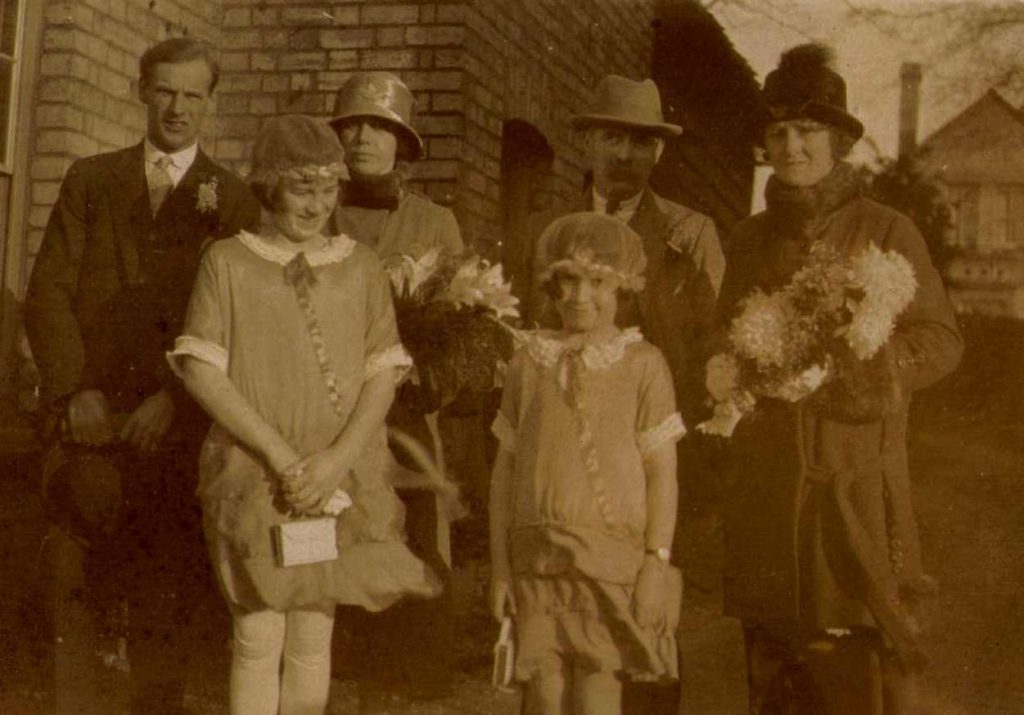
HOUSE PAINTER AND BUILDER
Eldest son, Herbert, who will continue our family line, married Alice Rider b1880 at Sawston in 1902. Alice was the daughter of Benjamin and Harriet Rider from Ickleton, Essex. Herbert and Alice had three children, Edgar Herbert b1905, Gertrude b1908 and Eric Albert b1913. Eric the younger will continue our family line.
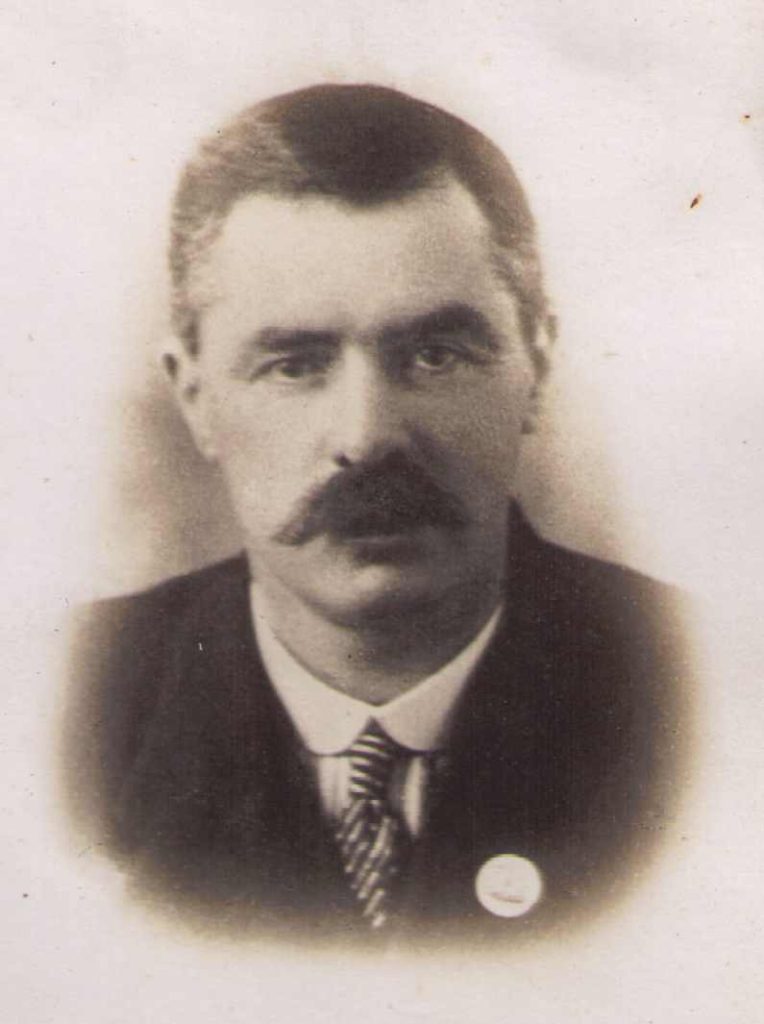
The first time we see Herbert at work is in 1901 when he appears to have followed his father Thomas into house painting. We have no idea if he was working in his father’s business but his father was still operating as a painter and plumber until his death in 1911, so it seems likely. However, indications are that Herbert actually had his own ideas and established a house painting or building business by 1900. He would have been 20 years old. Given that Herbert probably left school before he was 13 years then in relative terms he had worked for his father for a long while, probably from 1893 to around 1900.
We know that on Census night in 1901 Herbert was lodging with Benjamin and Harriet Rider at Mill Street, Ickleton, Essex. Alice Rider was Benjamin and Harriet’s daughter. This is significant because Herbert and Alice married in 1902 and continued to live in Ickleton. In 1904 Herbert gave Ickleton as his home address to the Bankruptcy Court in Cambridge; in regard to creditor claims made against a business he had established in Great Shelford in 1900.
So it appears that Herbert did have his own business, initially as a house painter 1900-2 and then later another, in partnership with William Henry Stent, as Parsons and Stent Builders. This latter business was established in Great Shelford as well, probably about 1902-3. Early on the business ran into difficulties and the proprietors, Herbert Parsons and William Stent, had to apply to the Cambridge Bankruptcy Court in 1904. Some 25 claims were made by creditors. Herbert and William were finally released from bankruptcy on April 8th 1907 after a final dividend payment of 3 shillings and 4 pence halfpenny. Herbert was still only 27 years old. At some point around this time Herbert and Alice moved from Ickelton to Hauxton, Cambridgeshire. Hauxton is just East of Great Shelford. The couple lived in Hauxton past 1913, as youngest son Eric was born in Hauxton, but soon after moved to a cottage in ‘The Terrace’, High Street, Little Shelford, where they lived for the next 15 years.
MILITARY SERVICE INTERVENES
We know from the family verbal archive that Herbert continued in the building trade after this difficult period working for other builders from around 1904 up until 1914 when he signed up for military service in WW1. His sign up papers into the Cambridgeshire Regiment of the Territorials showed that he was 34 years of age and had been working as a painter for W. Sindall’s – Builders, at Hauxton.
Herbert was not posted for active service but was made ‘storeman- private’ at the Peterborough Military Stores. Private 3103 Herbert Parsons served 1 year and 5 months before he was discharged because of ill-health (Tabes Dorsalis) at the Newmarket Barracks..
BUILDER AGAIN BUT ECONOMIC DEPRESSION INTERRUPTS
After being released from service because of ill health in 1916, Herbert re-established the building business as Parsons & Son. This was probably about 1918, when he was joined by his eldest son Edgar. Youngest son Eric recalled visiting building sites as a young boy. It is believed that there are still houses standing in High Street, Great Shelford, that were built by Parsons & Son.
In 1919 the British economy started to collapse, with unemployment rising to between 6 and 10% in southern England. Life must have been hard for a sole trader builder, such as Herbert, with fewer orders as debt was curtailed. Herbert closed his business and went to work, again, for the local builder, W. Sindall’s. The downturn continued, however, and Herbert found himself unemployed around 1926, when he was aged 45. He then successfully applied for a position, with wife Alice, to become caretakers at the Great Shelford Chapel. The couple then moved with the family from Little Shelford to Great Shelford, eventually renting a cottage in High Street, opposite the Chapel and next to the Square and Compass public house. This cottage (below) is still standing today, under heritage protection, as an example of an early English thatch cottage. Notice the height of the door, there was actually a step down through the door but was still pretty low. The cottage in the 1920’s was owned by the proprietor of the public house, seen adjoining.
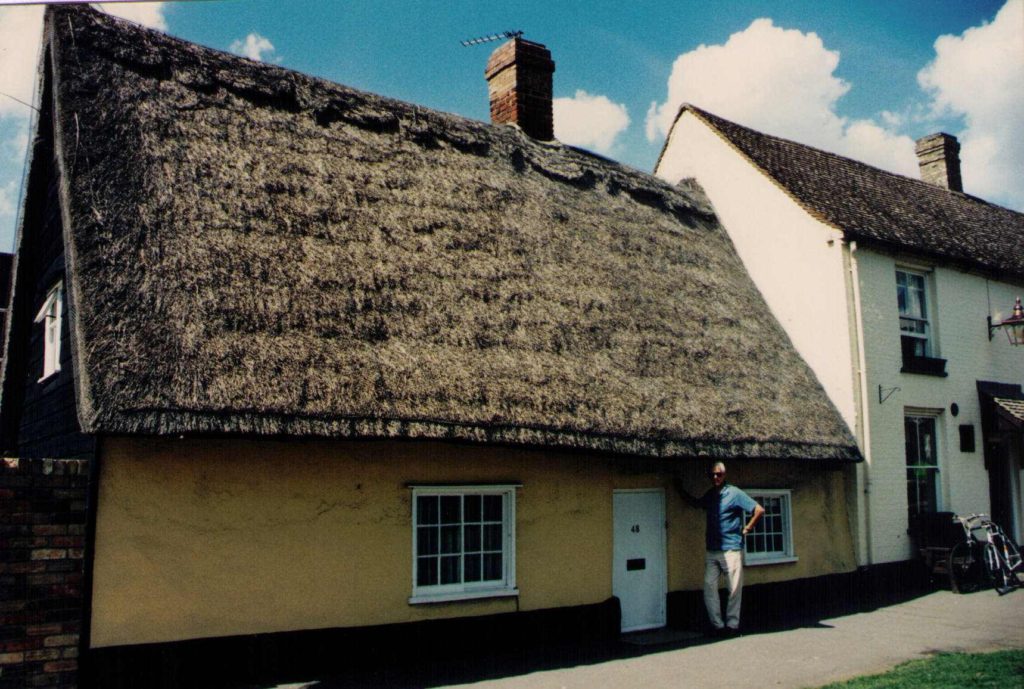
In 1929 the US share market crashed and Europe moved into the ‘great depression’, which lasted until the Second World War. Herbert was not going to be able to start his business again. Herbert and Alice continued as caretakers at the Chapel, but Alice became seriously ill in 1932 and was admitted to Addenbrook’s hospital in Cambridge. She died in 1933 aged 52 years. Herbert continued to live at High St., but became ill with lung cancer in early 1935, was also admitted to Addenbrook’s that year and died shortly after, aged 54.
A little more background on business partner William Henry Stent. William was 16 years older than Herbert, probably in his late 30’s when they first met. William was a Railway Coach Builder, as was his father Henry and he was born in Shalford, Essex. Father Henry Stent was a Timber Inspector for the Great Eastern Railway Co. Father and son started building wagons and coaches for the railway around the late 1800’s to the turn of the century. In the 1901 Census William is still shown as a Coach Builder but in 1911 he is listed as retired Coach Builder. William is living at Stanstead, Essex in 1911 with wife Ada, two sons and his mother. Interestingly William’s daughter was born in Great Shelford in 1905. This probably gives us a clue that William was probably living for a while in the Great Shelford area and may explain how William and Herbert met, to become partners. William died in 1940, aged 76, and was still living in Essex. It is doubtful that the pair continued as business partners after 1904.
Of the children of Herbert and Alice, Eric will continue the family line. Of the other children we know the following.
Edgar the eldest son followed his father into the house building business and this would have been about 1918 immediately after WW1. Edgar married Emily Goff b1905 in 1924, when they were both 19 years, and they had six children, Sylvia b1925, Rose Joyce b1926, Stanley b1929, Irene b1931, Margaret b1936 and Gladys b1937. Emily was the daughter of Thomas and Mary Goff from Leicester. Thomas was a Plasterer and may have moved into the Essex or Cambridgeshire area for work, which he obtained with Parsons & Son.
Although Edgar was originally working in the business Parsons & Son, when his father closed the business around 1924, Edgar was probably also unemployed. He soon took up gardening, as a business, for some of the larger houses around Great Shelford. He continued with this until he retired in the 1960’s. Edgar died in 1967 aged 62 years and Emily in 1979, aged 75 years.
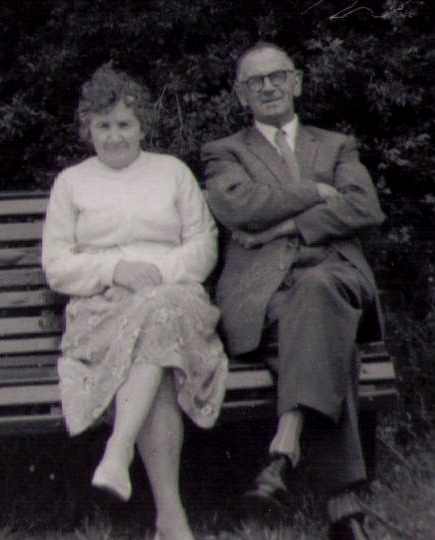
Of Edgar and Emily’s children. Sylvia went to Cleveland, USA. Joyce stayed single in Great Shelford, where she still lives in 2019. Stanley went to live in Newcastle on Tyne and we have no information in regard to his family. Rennie married Jack Neep; they had at least two children, Christopher b 1954 and Phillip b 1957, and lived in Great Shelford for many years. They then moved to live in Soham, Cambridgeshire. Jack died shortly after. Margaret married Graham Wolfe in 1962 and they had at least one child, Tracy Jane b1971. Margaret died around 2010. Gladys married Kenneth Sadler in 1959. We have no information in regard to her family.
Herbert and Alice’s daughter Gertrude or Gert married Sidney Scarr in 1935, the same year her father died. Sidney Scarr was an agricultural labourer who worked at the local dairy farm for a number of years but also did some labouring work for Herbert. They had no children but continued to live in the cottage in High St, Great Shelford, after Herbert and Alice’s deaths. Herbert’s youngest son Eric lived with them until he married in 1937. Gertrude ran her own confectionary shop in Great Shelford High Street for a number of years and that is her outside the shop below. When Sidney died in 1955 aged 57 Gertrude stayed living in the High Street house until the 1970’s when she then moved to Stapleford. Gertrude died in 1985 aged 80 years.
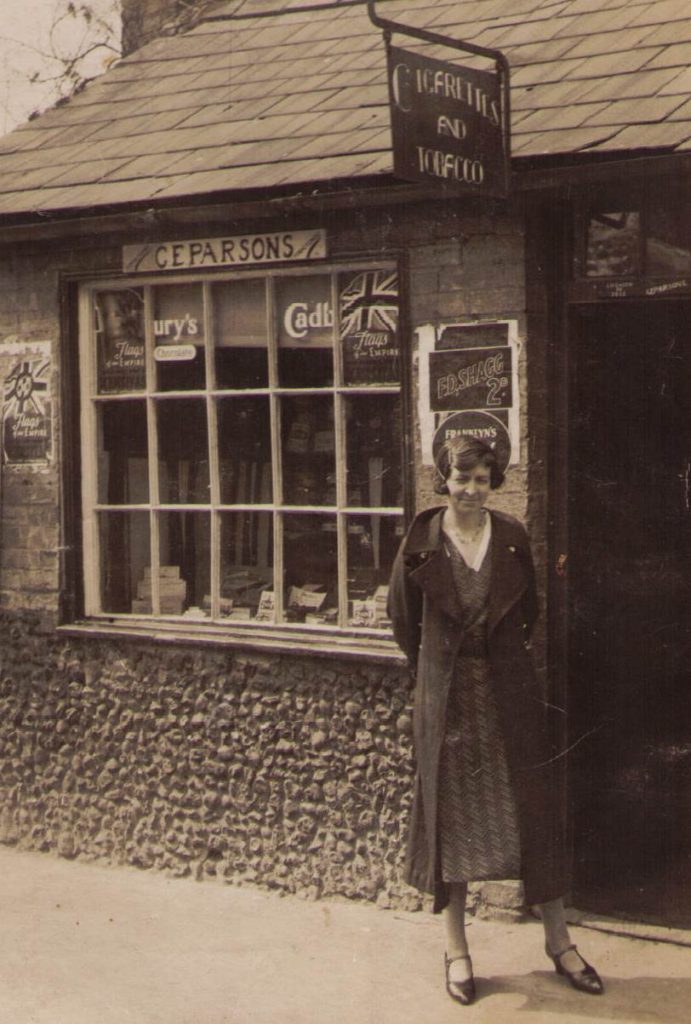
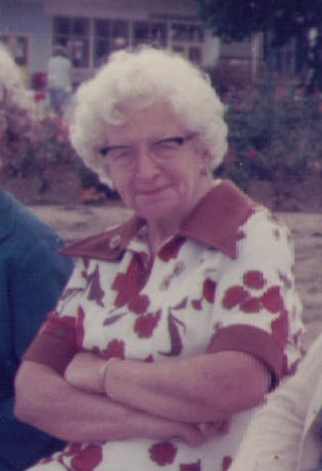
As indicated before; following the death of his mother and father, Eric the younger son, lived with his sister Gertrude and her husband Sydney in High Street, Great Shelford until he married Violet Titchmarsh in 1937.
IRONMONGERY AND DEPARTMENT STORES
Eric had left school when he was 13 years, in 1926, and attended Cambridge Technical College doing a carpentry trade’s course, that lasted two years. The motivation for this move seems to have been connected to future work opportunities that his mother Alice had initiated with leaders of the Chapel congregation. Eric completed his studies and immediately started work in 1928 as an ironmonger’s assistant at the large department store in Cambridge, Laurie & McConnell. The Manager of the store and the senior accountant were members of the Chapel congregation. In fact the senior accountant was the brother of the Vicar. Eric continued in this position, finally being promoted to Manager of Ironmongery, Furnishings and Appliances in 1937. In this year Eric married Violet Titchmarsh, a childhood sweetheart, and the couple moved to Cambridge to live and purchased a new house in a just completed cul de sac, Garry Drive.
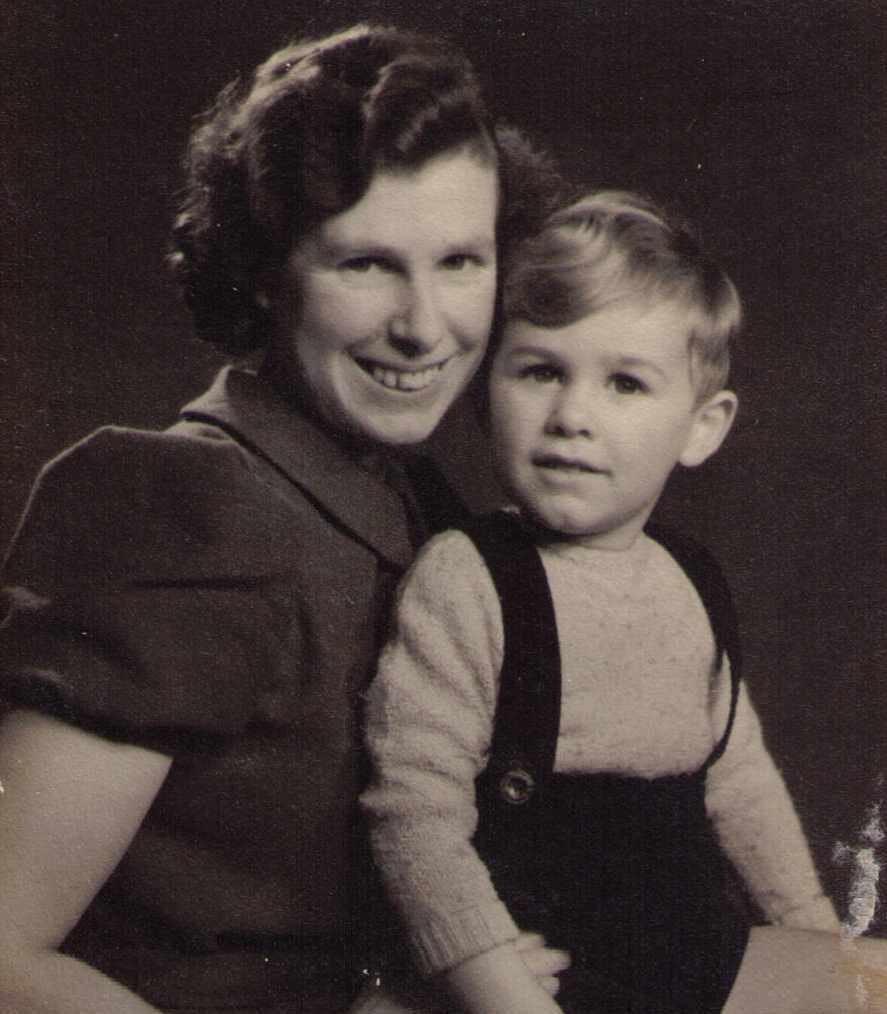
Their only child Anthony (Tony) was born in 1939. Shortly after this WW2 commenced and Eric joined the RAF. Eric trained in the RAF as an airframe fitter and was posted all over Britain to various RAF aerodromes.
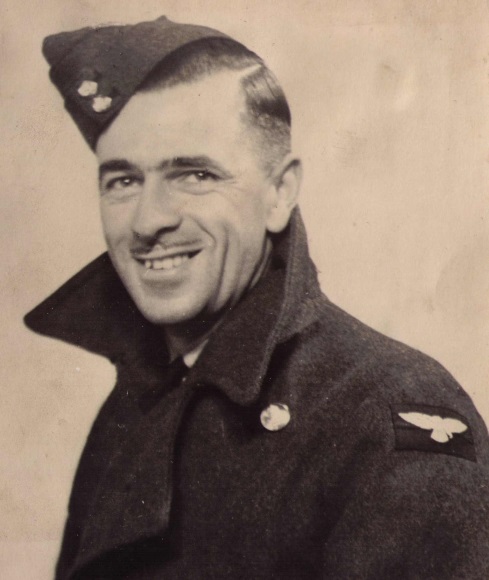
He was demobbed in 1945 and returned to work at Laurie & McConnell’s as Department Manager in a rapidly developing environment. Eric and Violet stayed in Cambridge until the late 1950’s when they then moved to Wrexham, North Wales with Eric taking up a General Manager and eventually a Director’s role with Engineering firm Rodgers and Jackson, Wrexham, Wales.
Eric retired in the 1970’s and the couple moved in 1975 to Melbourne, Victoria, Australia. In 1984, after a short return to the UK, they moved to the Sunshine Coast, Queensland, where they lived until they both died in 2016, both aged 102 years.
METALLURGY TO SOCIOLOGY IN AUSTRALIA
Tony began prep school at the Shirley in Chesterton, then St Andrews primary, before starting when 10 years old at the Chesterton Secondary Modern School for Boys. He continued to complete year 5 aged 15 and was School Head Boy in his final year. Despite this Tony didn’t do very well with his School Certificate.
After a short period as a trainee instrument maker Tony attended the then Cambridge Technical College and studied for advanced level Certificate in Maths and Science. After two years and not able to get a university entrance Tony commenced work as a laboratory assistant at the Research Laboratories of Tube Investments at Hinxton, Essex. After further night class studies for the National Certificate in Chemistry, Tony won a scholarship to attend Wednesbury Technical College, a specialist college for Metallurgical Studies, close to Birmingham. Tony passed his Higher National Diploma Metallurgy in 1963 and was awarded an Associate of the Institute of Metallurgists in 1964 for his research thesis paper on Weld Embrittlement in 307 Stainless Steel. Tony was promoted to Research Scientist at Tube Investments but only worked there for a further year before moving to Melbourne, Australia to work for the Commonwealth Aircraft Corporation.
Before leaving the UK, Tony married Marjorie Munro, who was from Blackley, Manchester, Lancashire. Tony had met Marjorie through student friends who came from Warrington, near Manchester.
Marjorie and Tony arrived in Australia in 1965 as ‘10 pound’ paid emigrants and the couple had their first child, Naomi Ann that year. Naomi was born in Melbourne while the couple were living in the St Kilda suburb. Marjorie also worked at the Commonwealth Aircraft factory as a Supply Clerk. They moved to Ringwood in 1967 and second child Stephen Munro was born in 1968.
Tony was promoted to Senior Metallurgist at the Commonwealth Aircraft factory, where he continued until 1970, when he left to start a metal welding and spraying business. Marjorie and Tony went into partnership with another couple who they had met through work. The business progressed quickly, employing at its peak four full time hard facers and welders. Unfortunately an economic downturn necessitated the business having to cut back overheads and Tony and Marjorie agreed to be bought out by the other partners in 1971.
Tony then commenced work with ICI Australia Ltd in the new products division of ICI Mond but this quickly folded because of the economic downturn and Tony was transferred to Atlas Chemicals, which was soon renamed ICI America. Tony’s new role was as Marketing Specialist for reinforced plastic products. Tony spent 3 months in Wilmington, Delaware, USA, being trained for this activity. At this time Marjorie entered Latrobe University to successfully study for a Bachelor Degree in Teaching.
By the mid 70’s further rationalisation had ceased the production of plastic resins and Tony was asked by ICIA to set up a Toxicology Information Section to commence the development of Occupational Health and Safety Standards for the Company. This Section was expanded to incorporate Emergency Response and Safety Monitoring activities. Tony returned to ICI America for training in toxicology.
At about the same time (1974) Marjorie and Tony agreed to separate and eventually divorce. Shortly after Tony met and commenced a defacto relationship with Carolyn Peasnell in 1976, another ICIA employee. The couple moved to the outer Melbourne suburb of Belgrave to live. Carolyn had three children, Kim, Jaqueline, and Cameron by former husband William Peasnell. Eventually daughter Naomi came to live with Carolyn and Tony. This relationship lasted until 1981, when the couple agreed to separate. Tony continued to live in Belgrave and continued to manage the ICIA Toxicology and Safety Unit. Of the children Jaqueline had left home earlier to live with father William and Cameron also went to live with their father when the couple separated. William Peasnell was a Policeman in Tatura, Victoria. Kim and Naomi stayed, on and off, with Tony in Belgrave.
In 1981 Tony met Rhonda Leigh Moore and the couple commenced a defacto relationship. Rhonda was a Community Development Worker in Fern Tree Gully and later CEO for the Eastern Regional TAFE Board. Rhonda had two children with her, Penelope and Cameron, from her previous marriage to Gavin Moore. Rhonda and Tony were both actively involved in the local Sherbrooke community and in particular in establishing, alternative schools, community learning programs, domestic violence programs and youth employment programs and activity centres.
In 1983 the couple both resigned from their work positions in Melbourne and moved to the Wide Bay Coast, Queensland with the intention of investigating fruit farming and generally a change of direction and interests. Rhonda reverted to her maiden name, Phillips, about this time.
The couple purchased 40 acres at a place called Anderleigh, along with two other couples, 25kms North of Gympie and relatively close to the coast. Naomi, Cameron and Penelope were with them. The couple had purchased a second hand sailing boat to renovate and sail in the Sandy Strait, while they waited for the fruit to grow and in between building a house.
Unfortunately the soil was not the best for commercially viable fruit and the couple decided to take up part time work and return to study at the University of New England. Rhonda completed a Bachelor of Sociology in 1988 and then commenced work as CEO of the Gympie Accommodation Program, where she had previously worked part time. Tony didn’t complete his degree at that time but commenced as CEO of the Gympie and Widgee Employment Program.
In 1989 Rhonda accepted a position in Brisbane with the Commonwealth Government and shortly after commenced with the State Department of Communities. Tony continued in Gympie until 1990, when he joined Rhonda in Brisbane and commenced work as CEO for the Logan Youth and Family Services organisation. Tony completed his Bachelor of Sociology shortly after commencing in this role.
Initially the couple lived in Morningside, Brisbane, but soon moved to Bulimba and then to Annerley and eventually West End. During this time Rhonda became General Manager of Community Housing Division in the Department of Housing. Penelope and Cameron went to University and Naomi married a Gympie man. In 2003 Tony resigned from Youth and Family Services and commenced a consultancy conducting social research for government and community groups. In 2004 he commenced employment with Care, a large church based charity, as Manager of Housing Services, finally retiring in 2009.
In 2005 Rhonda retired from the Department of Housing and returned to study a Masters at Queensland University, which she completed in 2007, Rhonda was then made a Senior Research Fellow in the Social Studies Research Unit at that University. Rhonda continued in that role until 2016, specializing in Indigenous studies. Complimentary to her work at the university was her role as a Director of the Palm Island Community Company. Rhonda continues this role in 2019.
After living together from 1982, Rhonda and Tony were married in 1998. They have lived in Brisbane, Sunshine Coast and finally retired just North of Brisbane in 2018.